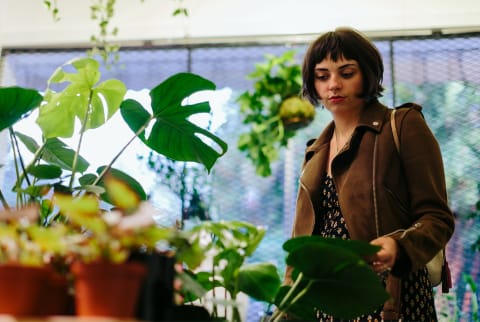Advertisement
This ad is displayed using third party content and we do not control its accessibility features.

mbg Contributor
Emma Loewe is the former Sustainability and Health Director at mindbodygreen. She is the author of “Return to Nature: The New Science of How Natural Landscapes Restore Us” and the co-author of “The Spirit Almanac: A Modern Guide To Ancient Self Care.” Emma received her B.A. in Environmental Science & Policy with a specialty in environmental communications from Duke University. In addition to penning over 1,500 mbg articles on topics from the water crisis in California to the rise of urban beekeeping, her work has appeared on Grist, Bloomberg News, Bustle, and Forbes.

Image by Cinema Tigers / Stocksy
August 23, 2024
We carefully vet all products and services featured on mindbodygreen using our
Our selections are never influenced by the commissions earned from our links.
The verdant indoor jungles of social media can appear to have every houseplant under the sun, but don’t be fooled: There are certain plants that even the most experienced of green thumbs don’t bring into their spaces.
When we asked a handful of plant pros about the finicky plants that don’t love indoor conditions, these are the ones that topped the list. Houseplant parents might want to think twice before buying them or at least be prepared to give them some extra TLC.
Ferns (particularly Maidenhairs)
According to plant coach and urban farmer Nick Cutsumpas, fine-leaved ferns like the Maidenhair can be hard to keep happy. “Their leaves are so delicate that any dry conditions (be it too much direct sun, or a missed watering) can lead to intense leaf shedding,” Cutsumpas tells mbg.
Alessia Resta of Apartment Botanist goes so far as to say that the Maidenhair fern is the one plant she’ll never purchase again. “I really love other ferns like the Bird’s nest and Boston fern,” she adds, “but the Maidenhair is one I would say to avoid—especially if you’re starting out and wanting to strengthen your ‘plant confidence.'”
With that being said, if you are up to the challenge of caring for these delicate beauties, placing them in the right spot is key. “Make sure to keep the fern in indirect light and high humidity,” says Cutsumpas. Since ferns are understory plants that love moisture, they typically do well in bathrooms that get natural light. In addition to consistent humidity, thirsty Maidenhairs also need a good soak every few days. Whenever the top of their soil feels slightly dry to the touch, it’s time to water.
If your fern’s foliage does eventually end up falling off or shriveling up into a crispy brown or yellow mess, don’t be discouraged! It happens to nearly everybody, and yogi and plant lover Roos Kocken adds that not all hope is lost. Houseplants can be surprisingly resilient, so once you diagnose the problem—be it too little water or not enough humidity—she says you may be able to nurse your finicky fern back to life.
Calatheas
You’ll find over 165 houseplants in Kocken’s Dutch collection—but none of them are Calatheas. Known for striking patterned leaves, this dramatic plant family has become really popular among collectors. “But be warned,” Kocken tells mbg, “they can suddenly crash and die for no clear reason, leaving plant parents to think they did something wrong or even that they are just bad with plants. It’s not you, it’s them!”
If you are going to buy a Calathea, she recommends doing so with the expectation that its beauty will be fleeting, like a bouquet of flowers. To give yours the best shot at lasting, read up on its specific care needs. Pro tip: Since many Calathea varieties can be super sensitive, Erin Marino, the editorial lead at NYC-based shop The Sill, suggests giving them distilled water instead of tap. This will reduce the likelihood of excess minerals building up in their soil.
The takeaway
Some plants are easier to care for than others, with Maidenhair ferns and Calatheas being two notoriously fussy picks. Know what you’re getting into the next time you purchase one of these demanding beauties, or just opt for a low-maintenance plant instead. (Snake plant, anyone?)
